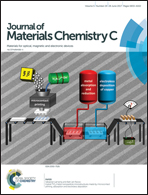Metal-enhanced fluorescence of gold nanoclusters adsorbed onto Ag@SiO2 core–shell nanoparticles†
Abstract
The static and time-resolved metal-enhanced fluorescence (MEF) of Au25-adsorbed Ag@SiO2 core–shell nanoparticles (NPs) has been studied systematically with the variation of shell thicknesses, core sizes, and excitation wavelengths. The emission of Au25-adsorbed Ag@SiO2 NPs is blue-shifted and highly enhanced compared with that of free Au25 clusters. The blue shift arises from the plasmonic coupling of Au25 clusters with Ag NPs, which decreases exponentially with the increase of separation between Au25 clusters and Ag NPs. The photoluminescence (PL) intensity of Au25-adsorbed Ag@SiO2 NPs is higher by a factor of 7.4 than that of free Au25 clusters. The PL enhancement of Au25-adsorbed Ag@SiO2 NPs is determined by two competing processes of near-field enhancement and fluorescence resonance energy transfer (FRET). The increase of the radiative decay rate constant with separation is identical to that of PL enhancement, suggesting that the MEF of Au25-adsorbed Ag@SiO2 NPs arises from the increase of the radiative decay rate constant induced by the near-field enhancement of plasmonic Ag NPs. Au25-adsorbed Ag@SiO2 NPs have also been found to be a highly sensitive and selective ‘turn-off’ sensor for Cu2+ ions.



 Please wait while we load your content...
Please wait while we load your content...